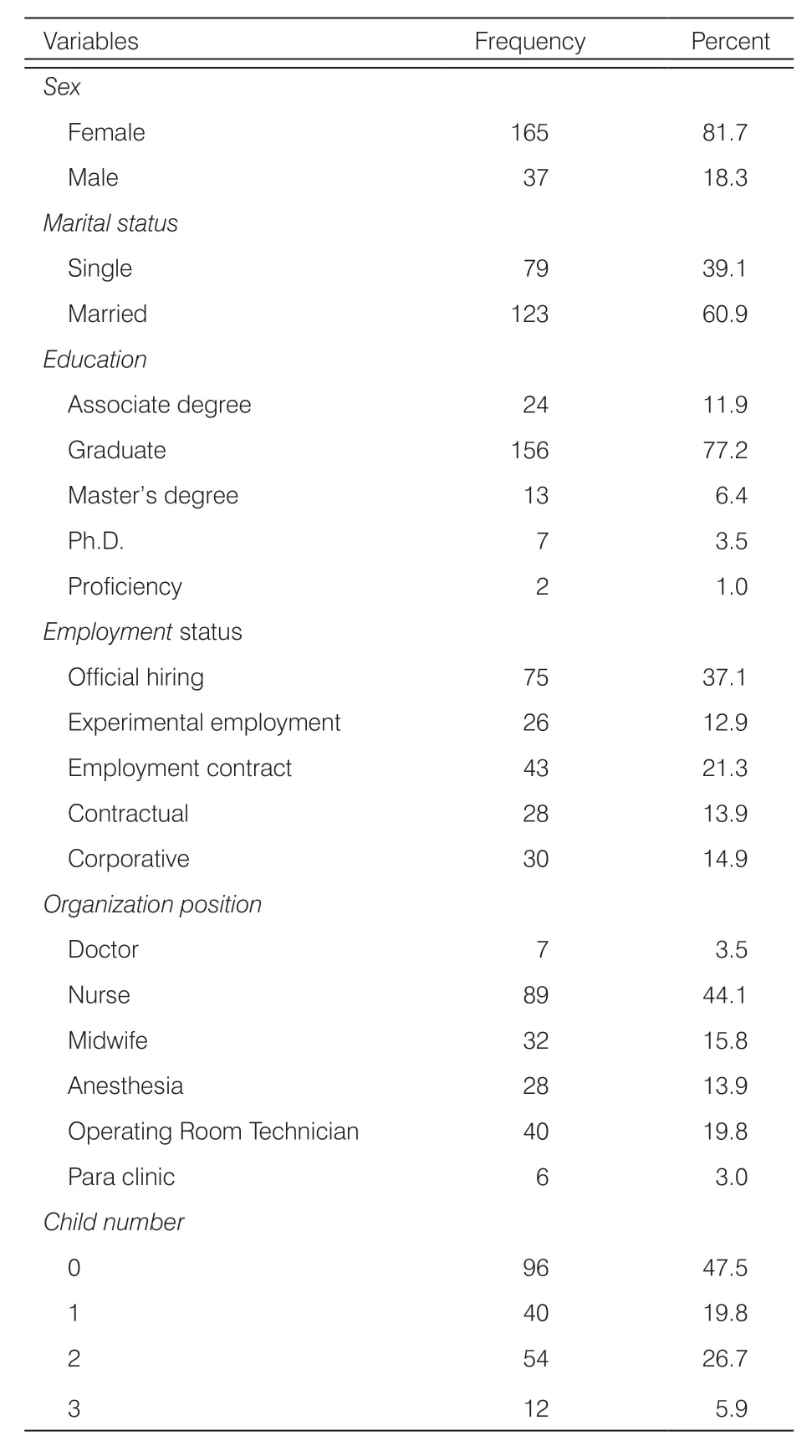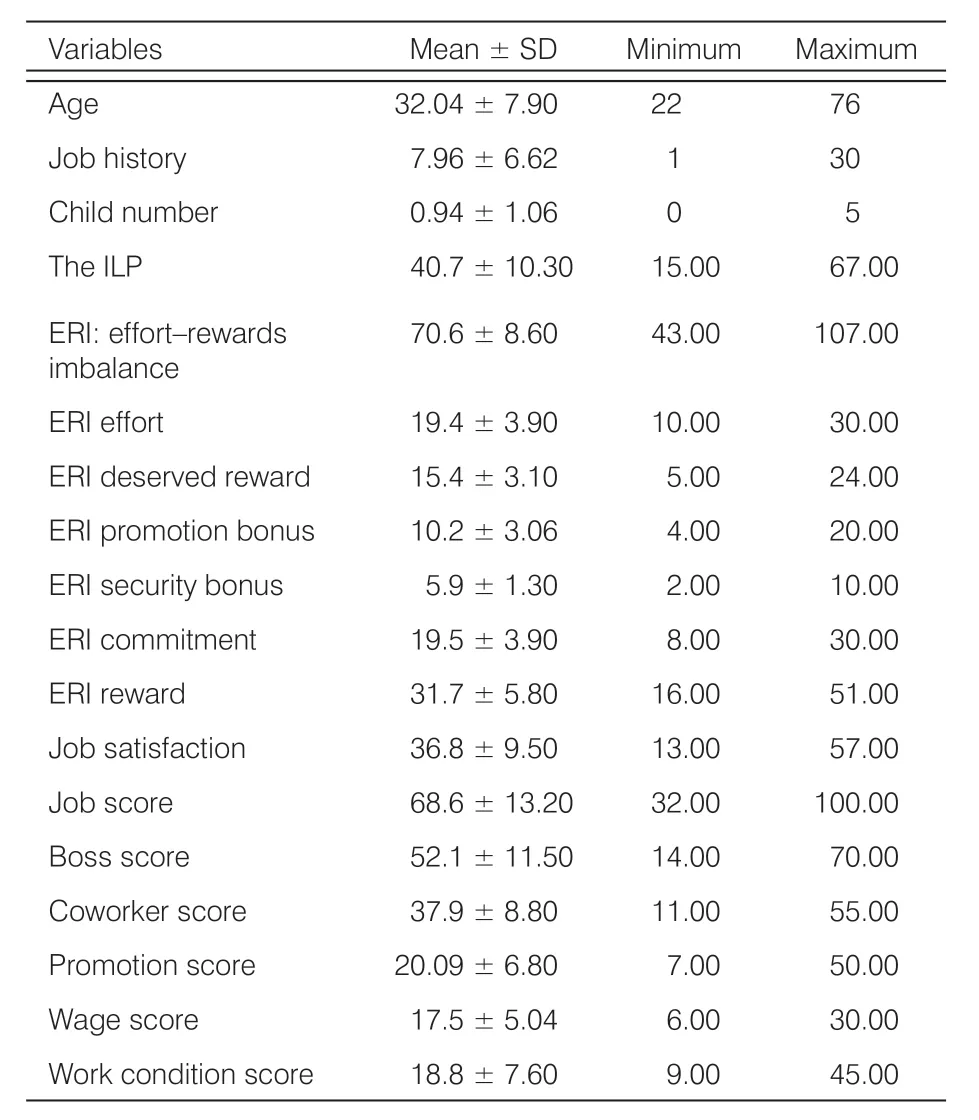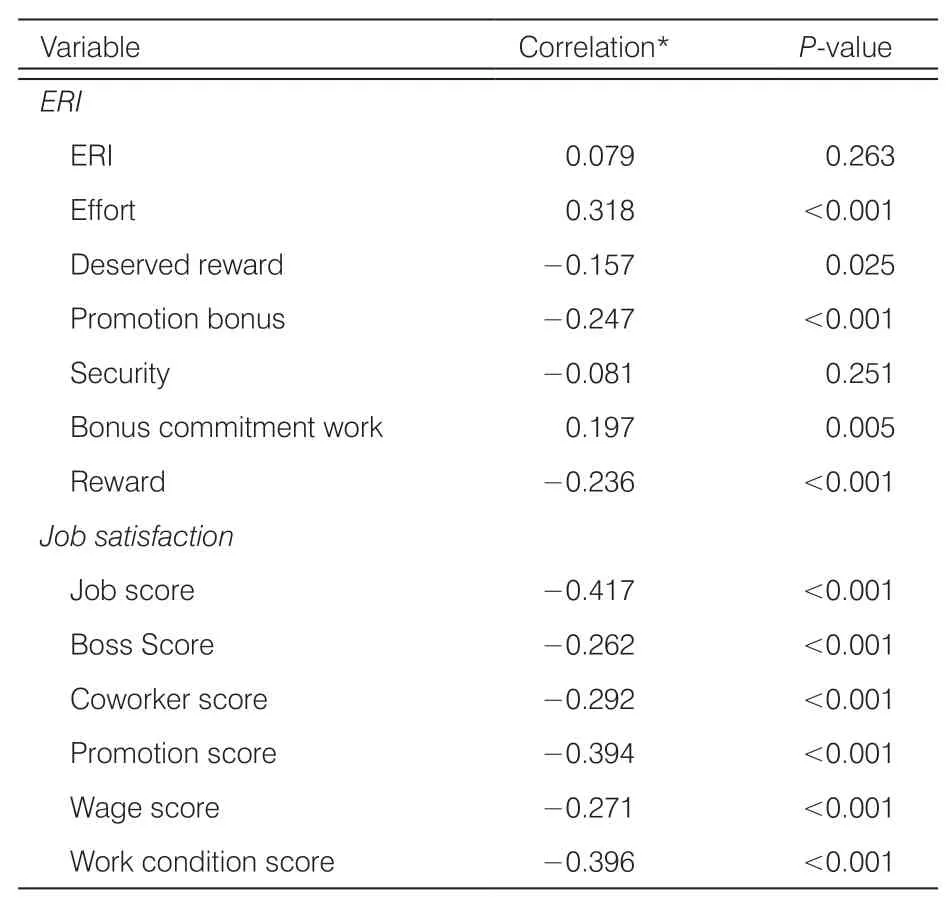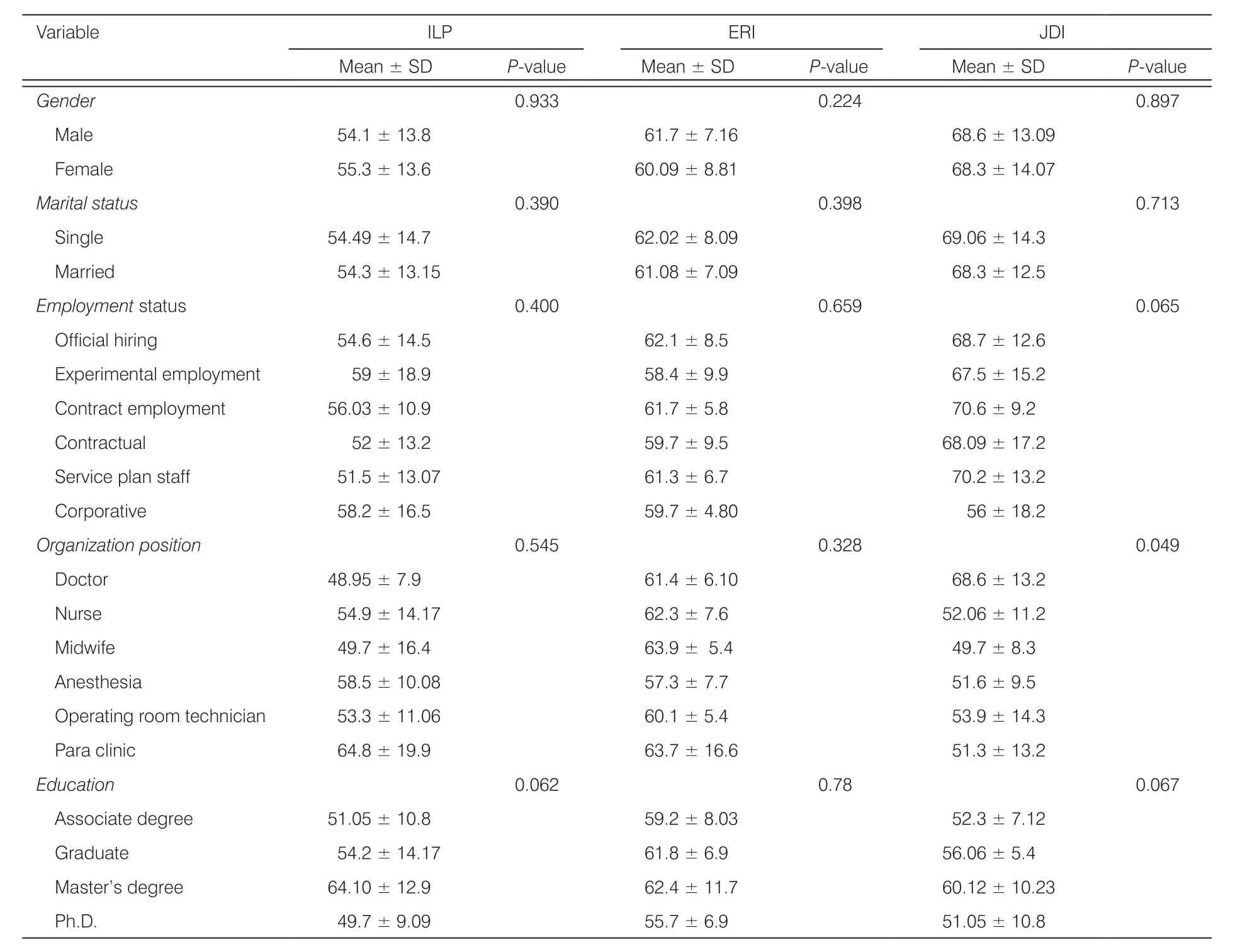Relationship between effort-reward imbalance, job satisfaction, and intention to leave the profession among the medical staff of Qom University of Medical Sciences†
Azdh Asgrin, Mohmmd Asini, Roghyh Sdghi, Ftmh Mod, Hmid Asysh, Aolzl Mohmmdigi, Frhnz Hshmti, Frznh Mhdinpour
aDepartment of Nursing, Qom University of Medical Sciences, Qom, Qom 37185, Iran
b Department of Clinical Psychology, Saveh Branch, Islamic Azad University, Saveh, Iran
c Department of Nursing, Faculty of Paramedical Sciences, Qom University of Medical Sciences, Qom, Qom 37185, Iran
dResearch Center for Environmental Pollutants, Qom University of Medical Sciences, Qom, Qom 37185, Iran
e Department of Midwifery, Medical and Health Care Center, Isfahan University of Medical Science, Isfahan, Isfahan 3717978311, Iran
f National Medical Emergency Organization, Ministry of Health & Medical Education, Tehran, Iran
Abstract: Objective: The effort-reward imbalance (ERI) model claims that work that has the characteristics of high effort and low reward has a mutual defect between input and output and this imbalance may result in sustained and long-lasting results. This study aimed to investigate the relationship between the intention to leave the profession (ILP) and ERI and job satisfaction among the medical staff in Qom Province.Methods: A descriptive-correlative study was conducted on 202 medical staff in Qom Province based on random sampling in 2018. Demographics checklist, standard ILP, job satisfaction, and Siegrist’s ERI questionnaires were used for data collection. The chisquared test, independent t-test, and one-way Analyses of Variance (ANOVA) were used to analyze data.Results: The mean age of employees was 32.04 ± 7.9 years, and 165 (87.1%) of the employees were women. The results showed that the medical staff was willing to leave their profession at a moderate level (40.7 ± 10.3). There was no significant relationship between demographics and ILP. Nevertheless, a significant and inverse relationship was observed between ERI (r:0.318, P < 0.01) and ILP (r: 0.197, P < 0.01). Leave the profession (LP) had a negative correlation with the dimensions of job descriptive index (JDI) such as job, manager, coworker and wage score (P < 0.01, r: -0.147, r: -0.262, r: -0.292, r: -0.271, r: -0.396).Conclusions: According to the results, managers need to make sure that their working staff is rewarded as they deserve. According to the results, managers need to ensure that the reward factor is observed for the staff, while an ERI imbalance may contribute to ILP of the staff. On the other hand, it leads to job satisfaction.
Keywords: effort-reward imbalance · intention to leave the profession · satisfaction job © Shanxi Medical Periodical Press.
1. Introduction
In the modern, complex, organizational world, it is important to understand that the main organizers behind any organization are human resources, who are the entities that satisfy the goals of organizations. Therefore, it is of crucial importance to study human behavior in organizations.
Job satisfaction is one of the multidimensional structures of work behavior that has attracted rapt attention in recent years.1Job satisfaction relates to the beliefs and emotions that individuals have about their work and their job. It has been described as an attitude with an affective and cognitive part2and the pleasurable emotional state resulting from the evaluation of one’s job as achieving or facilitating the achievement of one’s job values.3Healthcare professionals comprise an important group of individuals who are affected by emotional states and stress because of their unique work environment. The staff’s stress level and satisfaction with their profession are primary factors influencing their quality of work and individual productivity.4Factors like incentives and rewards are the most preferred elements for staff motivation programs.5,6
In the early 1980s, the American sociologist and physician, Siegrist7, founded the effort-reward imbalance (ERI) model. ERI is the theoretical model of a psychosocial work environment with adverse effects on health and wellbeing that focuses on a mismatch between high efforts spent and low rewards received at work.8This model claims that work that has the characteristics of high effort and low reward has a mutual defect between input and output. This imbalance may result in sustained and long-lasting results. Therefore, working hard but without proper reward is an example of imbalance that can cause stress, and if these conditions continue for a long time, it will cause autonomic nervous system disorder as well as physical and mental illnesses. There is some evidence that there is a relationship between the imbalance between effort-reward and a variety of mental illnesses, occupational defections due to illness, and complaints caused by decreasing health and physical health.9
The results of a study showed that low intention to leave the profession (ILP) negatively affects ERI. This indicates that ERI might be a risk factor.10 ILP is very costly for an organization and the cost is due to the termination, publication, employment, selection, and hiring of the staff. A study reported that 60% of hospital budgets are spent on staff recruitment and training.11 Similarly, Another study confirmed the relationship between ILP and some psychological factors in the workplace, such as job satisfaction.12The intention of staff to leave is a serious issue. When the working staff of an organization is happy and satisfied with their profession, they are loyal to their organization and rarely leave their profession.13 Furthermore, effort and reward equity at work affect staff’s work-related attitudes, especially job satisfaction and the intention to leave an organization.14The intention of the staff to leave their professions can be explained as rational choices taken at a cognitive end regarding the present profession or organizations or both.15It is necessary to conduct a study to assess the job satisfaction of employees and its relationship with the amount of reward and effort, and leaving the profession. When employees are not rewarded for their efforts, job satisfaction decreases and the tendency to leave the profession (LP) increases. Therefore, the purpose of this study was to investigate the relationship between reward imbalance and leaving the profession and job satisfaction among the clinical staff of Qom University of Medical Sciences.
2. Methods
2.1. Study design
This study was a descriptive-correlative study whose participants comprised 202 medical staff at Qom University of Medical Sciences including physicians, nurses, midwives, anesthesiologists, operating room technicians, and par clinic technicians. This research was conducted in Qom educational hospitals.
2.2. Participants
This study was a descriptive correlational study in which 202 medical staff of Qom University of Medical Sciences in 2018 including physicians, nurses, midwives, anesthesiologists, operating room technicians, and para clinic technicians were treated. The research was conducted in Qom teaching hospitals and was approved by the research deputy of Qom University of Medical Sciences. The total target population in this study was 3,500 people, so according to the Morgan table, the required sample size was 250 people and 202 questionnaires have been returned from this number. The sampling method was random. A random number table was used to randomize the samples. Sample size calculation was conducted by considering power 80%, confidence interval 95%, and correlation coefficient (r= 0.20). Inclusion criteria included medical staff that was working and willing to participate in the study. It was also necessary to have at least an associate degree and at least 1 year of work experience to enter the study. Exclusion criteria included people who did not want to complete the questionnaire and participate in the study. With the permission of the hospital manager, the questionnaires were completed in the staffrooms of the health staff.
2.3. Measurement
The demographic questionnaire included eight questions such as the age and gender of the participant, work experience, marital type, education, organizational position, employment status, and the number of children. Moreover, job descriptive index (JDI), ILP, and ERI questionnaires were used to collect the data.
2.3.1. ILP questionnaire
The ILP questionnaire comprises 15 questions in five Likert-scale responses designed to assess the propensity to LP in three different aspects: social, individual, and environmental. The content validity of the questionnaires was evaluated based on expert judgments. Cronbach’s alpha coefficient was 0.80 for the ILP questionnaires. In Li et al.23study in 2005, for the face validity of the questionnaire and the accuracy of the questions, the questionnaire was distributed among some students and after confirming the results, the questionnaire was distributed in a statistical sample. Also, Cronbach’s alpha for the leave of absence questionnaire is equal to 0.82. In this questionnaire, a higher score indicates a lower intention to leave the job.16
2.3.2. ERI questionnaire
The ERI questionnaire was originally designed by Seigritz in 1996 and revolves around the notion that the imbalance between effort and reward in social services can lead to a level of stress and tension among the staff. The questionnaire includes 23 questions with three domains of effort (6 questions), reward (11 questions), and commitment (6 questions). The content validity ratio of the Persian language questionnaire was calculated using the content validity index (CVI) (CVI = 0.79). Moreover, the questionnaire was given to 10 faculty members of the faculty of nursing and midwifery to comment and after applying their opinions, the questionnaire was administered (CVR = 0.62). To test the reliability of the questionnaire,17a test-retest (above 0.70) method was used with Cronbach’s alpha coefficient at 0.77.
The scoring of the ERI questionnaire is based on a five-point (1-5) Likert scale ranging from very low to very high (which included Very low, Low, Medium, High, and Very high). The questionnaire has three subscales including effort, reward, and work commitment. The highest score is 55 while the lowest is 11. To get a score for the whole, the sum of the scores of the questions is collected. The highest score a person can achieve on a subscale is 30 and while lowest score is 6. The higher the score on this scale, the higher the individual’s effort and stress level. A low score in this subscale indicates high stress and a high score means low stress and a high reward in the job. The highest score a person receives under a commitment scale is 30 and the lowest score is 6.7
2.3.3. JDI questionnaire
One of the most reliable tools for measuring job satisfaction is the Job Descriptive Index questionnaire. The questionnaire was developed in 1969 by Smith, Kendall, and Hyulin. The JDI questionnaire measures six aspects of work and job satisfaction: job, boss, coworker, promotion, and wage and work condition. The Persian version of this questionnaire was prepared by Behroozi et al.,17with some modifications in the scoring procedure. Cronbach’s alpha and criterion validity of this questionnaire is 41%. The scoring system of the questionnaire is based on a Likert scale. On each subscale, scores are added to get a subscale score. The questionnaire has been observed and approved by several experts.17
Demographic parameters including age and gender of the participant, work experience, marital type, education, organizational position, employment status, and the number of children were reviewed. Furthermore, parameters including ILP and the imbalance between effort and reward were investigated.
2.4. Data analysis
Descriptive statistics (mean, standard deviation [SD], and frequency) were used to explore the data. Moreover, an independent-samplet-test and one-way Analyses of Variance (ANOVA) were used to compare the mean scores among groups. The chi-square test was used for the comparison of qualitative variables. Pearson correlation test and linear regression analysis were performed to assess the relationship between ILP and ERI. Data analysis was conducted using the SPSS 20 software (SPSS, Chicago, IL, USA). AP-value of <0.05 was considered as significant in all the analyses.
3. Results
Initially, 250 staff members were invited to participate in the study; 23 staff members did not consent to participate in the study and 25 staff did not fill in the questionnaire completely. Therefore, finally, the questionnaire of 202 employees was analyzed. The mean age of the staff was 32.04 ± 7.9 of which 165 (87.1%) were women. Based on our findings, the majority (123, 60.9%) were married and 156 (77.2%) had graduate degrees; >30% were officially employed on a full-time basis. Less than half of the respondents (44.1%) in the study were nurses. Table 1 depicts the demographic and occupational characteristics of the study participants. The highest mean scores and SD of ERI and ILP and JDI were 70.6 ± 8.6, 40.7 ± 10.3, and 36.8 ± 9.5, respectively. The ERI questionnaire had the highest mean of ILP and job satisfaction. The mean scores of studied variables among the hospital staff are presented in Table 2.

Table 1. Demographic characteristics of occupations participating in the study of Qom University of Medical Sciences 2018.

Table 2. The mean and SD job satisfaction, effort-rewards imbalance, and ILP.

Table 3. Correlations between ILP and the scores of ERI and satisfaction job and its dimensions.
The Pearson correlation coefficient test (Table 3) was applied to assess the relationships among JDI, ILP, ERI, and dimensions of EIR questionnaires. The results revealed that there was a significant correlation between ERI with effort (r: 0.318) and commitment with ILP (r: 0.197) (P < 0.01). ILP had a negative correlation with the dimensions of JDI such as job, manager, coworker, and wage score (P< 0.01,r: -0.147,r: -0.262,r: -0.292,r: -0.271,r: -0.396), and there was a negative correlation between ILP and ERI promotion (P < 0.01, r: -0.247). Pearson’s correlation coefficient of 0.318 indicated a strong correlation between ERI effort ILP and the weakest correlation was observed between the job scores of ILP.

Table 4. Relationship between ILP and ERI and JDI with demographic characteristics.
To compare the mean and SD of JDI, ILP, ERI, and dimensions of EIR questionnaires, independent t-test, and ANOVA were used. Our results did not show any significant relationships among ILP scores and gender, marital status, employment status, and organizational position. Also, there was no significant difference between the levels of education and ILP, but the highest mean and SD was observed between ILP and the education level of the staff, especially master’s (64.10 ± 12.9). According to descriptive statistics, women had higher ILP willingness than men and single workers more than married ones. By contrast, single and female staff felt more inequality in effort than married ones. The relationship between demographic characteristics and ILP is depicted in Table 4.
4. Discussion
Based on the findings of the present study, proper effort and adequate reward in work are the basic dimensions of healthy work. Our results showed that there was no relation between ERI and ILP. Nevertheless, there was a positive relationship between the effort scale and ILP. By contrast, variables such as gender, the status of influence, job status, and organizational status have no relationship with the intention to leave the job (ILP). Women are more likely than men to have ILP and single employees than married people. In addition, older employees feel the non-exchange of reward rewards (ERI) but use them to quit their jobs.
According to the descriptive statistics, in the present study women tended to leave their professions more than men did, and single staff more than married staff. This finding is in agreement with the results of the study by Pélissier et al.18It can be argued that women are more inclined to leave their professions for a variety of reasons, including their responsibility toward the house and the loss of organizational commitment.
Our findings regarding the greater possibility for the younger staff to leave their professions supports the results of studies by Aiken et al.,19Wieck et al.,20and Flinkman et al.21The results of these studies demonstrated that young nurses are more unfamiliar with their professions and earn less. These factors can assist in further dissatisfaction with the profession in the younger age groups.22Besides, younger staff are less present at work and they do not invest emotionally in the organization.
A person’s situation is effective in their intention to leave their profession. Various studies have shown the relationship between the demographic variables such as marital status and intention to leave. In terms of marital status, single (unmarried) men are more vulnerable to switchovers than married ones.13In general, research demonstrates that female staff, married ones, those with higher education and permanent professions, and those with advanced increments and high salaries are eventually more likely to stay in the clinic.23,24
The findings of this study also revealed that medical staff felt a greater imbalance in ERI but they did not want to leave their profession because they had gone through the critical condition; moreover, the unofficial staff was more likely to intend to leave their profession. Yet, it seems that older staff feel more imbalance, so in hospitals where there is a balance between performance and reward, the medical staff strives purposefully to promote transcendent goals perception.11
Formulating a sense of justice in the organization leads to a feeling of satisfaction with enhanced productivity, reduced work leaves, and increased work commitments. Our study showed an average ERI of 70.6 in the samples.
A positive relationship was found between organizational justice on the employee innovative work behavior and knowledge sharing based on Akram et al.’s study.25Additionally, it was observed that there was a negative relationship between rewards and ILP with regard to the ERI model by Li et al.23Low job rewards may be a decisive factor in ILP. The possibility of leaving one’s profession is considerably high for someone who puts more effort into their profession. This would induce frustrations with received rewards and make them more likely to leave their profession.
According to the results of this study, there was no relationship between ERI and ILP. But there was a positive relationship between effort scale and ILP. The findings of this study also demonstrated that ILP could negatively affect the balance of effort and reward. Thus, as stated by Bethge et al.,10ERI might be a risk factor that increases the chance of ILP or health-related issues leading to early retirement.
The results also revealed that there was a negative correlation between job satisfaction dimensions and ILP. It has been frequently claimed that a negative correlation between job satisfaction and ILP is the determining factor behind ILP.26,27As a result, it may be assumed that medical staff tends to leave because of low salaries, poor working conditions, lack of promotion, and the nature of the profession. The working staff who experience inequity between effort and reward are found to have a five-times higher risk of job dissatisfaction.26Besides, feeling dissatisfied with their profession, they tend to develop ILP and hence leave their organization and even their profession. Similar to any study, this study had its limitations and insufficiencies, thus the issue needs to be explored further. The relevant planning and its execution should be strong enough to be able to cope with such a problem.
The main limitation in the study was the number of participants in the study who did not have the opportunity to complete the questionnaire due to lack of time. However, some people were not careful enough to complete it and because of this, some forms were removed. It is suggested that more research be done with a higher number of samples.
5. Conclusions
According to the results, managers need to make sure that their working staff is rewarded as they deserve. Therefore, the medical staff of organizations should be motivated to be rewarded for decent job performance, and they should be informed of the reward. If they are not rewarded as they should and if factors influencing the reception of rewards are kept unknown to them, the possibility of leaving professions increases. It is suggested that employees be rewarded and that a balance be struck between effort and reward to increase job satisfaction and reduce the tendency to LP.
Ethical approval
The study proposal was approved by the Vice-Chancellor for Research of Qom University of Medical Sciences. Medical Ethics Committee (MEC) of Qom University of Medical Sciences approved the study protocol (Code of Ethics: IR.MUQ.REC. 97993). The questionnaire was completed with informed consent by the participants. All information about employees is protected and the results of the study are published in groups.
This project was approved by the ethical committee of Qom University of Medical Sciences by IR.MUQ.REC. 97993 at 2019.03.05.
Conflicts of interest
All contributing authors declare no conflicts of interest.
- Frontiers of Nursing的其它文章
- Application of a perioperative nursing strategy in the surgical treatment of elderly patients: a narrative review†
- Inter-Professional-Compassionate pain management during endotracheal suctioning: a valuable lesson from a Chinese surgical intensive care unit
- Evidence-based practice profiles of nurses: a transcultural study†
- Identifying the core competencies of backup nurses in the acute care hospital through a modified Delphi process†
- Undergraduate nursing students’ experiences of online learning: gaining access in resource-limited circumstances†
- Relationship between spiritual well-being and Health-Related Quality of Life and some related factors in patients with AIDS/HIV

